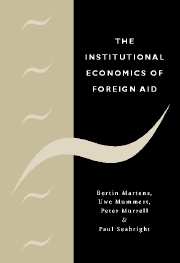Book contents
- Frontmatter
- Contents
- List of figures
- Foreword by Elinor Ostrom
- 1 Introduction
- 2 Conflicts of objectives and task allocation in aid agencies
- 3 The interaction of donors, contractors, and recipients in implementing aid for institutional reform
- 4 Embedding externally induced institutional reform
- 5 The role of evaluation in foreign aid programmes
- 6 Some policy conclusions regarding the organisations involved in foreign aid
- Index
Foreword by Elinor Ostrom
Published online by Cambridge University Press: 22 September 2009
- Frontmatter
- Contents
- List of figures
- Foreword by Elinor Ostrom
- 1 Introduction
- 2 Conflicts of objectives and task allocation in aid agencies
- 3 The interaction of donors, contractors, and recipients in implementing aid for institutional reform
- 4 Embedding externally induced institutional reform
- 5 The role of evaluation in foreign aid programmes
- 6 Some policy conclusions regarding the organisations involved in foreign aid
- Index
Summary
The authors of this excellent book address the question of why international foreign assistance programmes have so rarely achieved the goals set out for them by the donor community. Following the Second World War, despite massive transfers of funds from developed countries to developing countries, many developing countries have seen little improvement in economic growth. The opportunities offered to their populations are still quite limited, even though the record in regard to health statistics has improved more than economic and social conditions in many developing countries. The authors do not attribute the cause to a plot fomented by immoral individuals trying to use public funds for private gain – even though such individuals can be found to operate in this terrain. Rather, the cause is less dramatic, but more plausible. The cause is the set of incentives facing the diverse actors involved in the chain of aid delivery.
All public agencies have been created to achieve multiple goals, but they cannot all be achieved simultaneously. Diverse actors within and outside public agencies are usually more interested in seeing one set of goals accomplished over others. Thus, the public sector is often best characterised as having multiple and sometimes conflicting goals, as well as multiple principals who tend to push for the achievement of different goals.
- Type
- Chapter
- Information
- The Institutional Economics of Foreign Aid , pp. vii - xPublisher: Cambridge University PressPrint publication year: 2002

